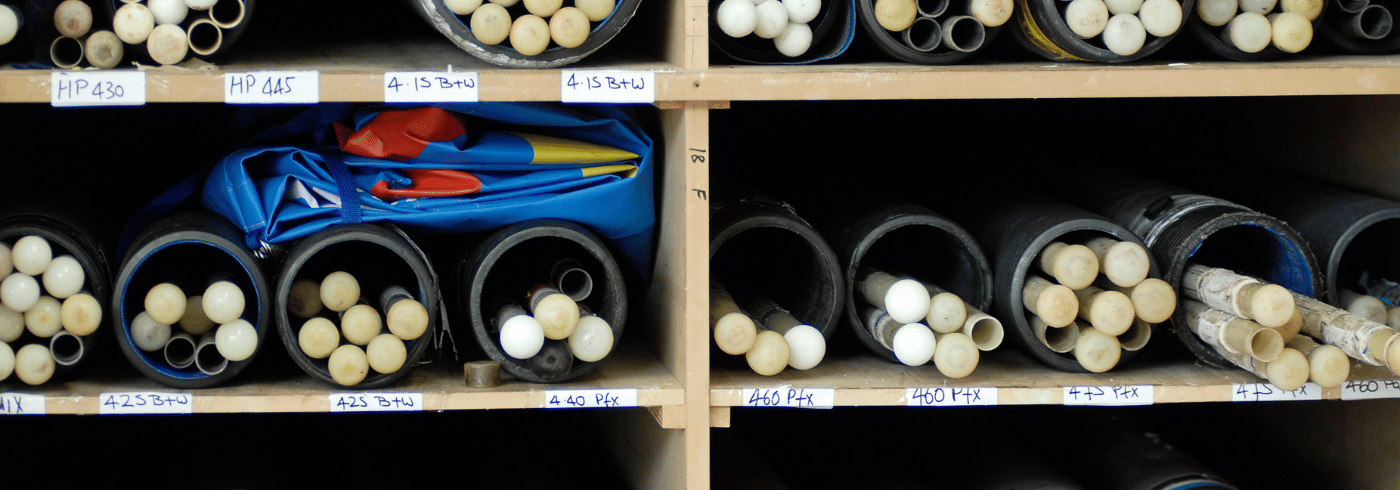
Vaulting Poles: Fibreglass vs Carbon Fibre
BY OWEN HEARD
If you're new to pole vaulting, you may wonder what vaulting poles are even made of, and you may also ask what the difference is between the types of materials.
Here, I will summarise how vaulting poles are made and what their main features are. Then, I will talk about the purposes of the different types, their functional strengths, weaknesses, and my personal preferences and recommendations.
WHAT ARE VAULTING POLES MADE OF?

A vaulting pole is a hollow tube manufactured using thin strips of material (fibreglass/carbon fibre) wrapped around a mandrel (steel rod) which is eventually removed. Resin-impregnated Fibreglass is the standard material for making poles, and a carbon-fibre composite equivalent is a less-common alternative.
HOW ARE VAULTING POLES MADE?

These layers of material are wrapped around the mandrel tightly using machinery. Once the mandrel is removed (after the initial layers have been wrapped), thicker layers are bound onto the hollow pole structure using heated rollers. This now multi-layered pole is heated inside an oven to liquify the resin and cure it, making it a solid unified pole.
HOW BENDY ARE VAULTING POLES?

After the manufacturing processes are complete, the pole is then tested in a "Flex Machine", which bends the pole massively, and tests its stiffness. A "flex" rating is given to the pole, which ultimately tells you how stiff the pole is. For example, a 12.0 flex is extremely stiff and would be used by someone jumping close to 6 metres, and a 25.0 flex is much "softer" (bendier).
The Flex Machine also puts an initial bend into the Fibreglass, or Carbon-fibre pole, which will stay in the permanent direction in which it will bend when jumped on. The bend is very subtle, and you can only notice it while holding a pole yourself, feeling the weight distribution.
Any damages will become apparent during the flex test as the pole would simply snap, or shatter whilst being bent to its limit. This can, rest assured, make the vaulters feel confident in the equipment they are using.
HOW MUCH DOES A VAULTING POLE WEIGH?

A maximum weight rating is given to the pole, indicating how heavy an athlete can be if they are to vault on it. Exceeding this value and vaulting on a pole rated lighter than your body weight (e.g. a 170lb person vaulting on a 160lb pole) could damage the pole.
This weight rating corresponds roughly to flex. A heavier-rated pole will also be a stiffer pole, while a lighter pole will be more flexible.
Of course, the stiffer the pole, the wider the tube is. The longer the pole, the heavier it is. Poles aren't that heavy in terms of total weight, only a few pounds. However, when holding at the end, it effectively weighs 20 lbs upwards, depending on length (this is because of leverage). A tough feat to run with at high speed!
FIBREGLASS POLES VS CARBON POLES
CHOOSING THE RIGHT VAULTING POLE
First and foremost, I recommend a standard, fibreglass pole for any new vaulter. Learning to bend a pole itself is a challenge when starting off. Using a typical pole will make beginner vaulting much more consistent and easy to coach, and it'd be more likely that there is a similar supply of poles to progress onto. As carbon fibre is less common and sometimes more expensive, there might not be a set of these lying around for someone to use. But a vaulter you know likely has access to fibreglass poles. Therefore, Fibreglass is generally more diverse.
That being said, many training groups do have access to carbons, and some athletes vault on them without even knowing. I wasn't aware of it while doing so in my first few years of vaulting!
Professionals tend to use either. Many vaulters have a full range of fibreglass poles, while others use carbons. They may interchange during training, but it is most likely that they have one favoured pole type, which they always use for competition.
Mondo Duplantis uses fibreglass, Sam Kendricks uses carbon fibre, etc. It's all down to preference.
WHAT IS THE DIFFERENCE?
Quite frankly, weight.
The properties of the poles are very similar, and any two poles of the same length and the same flex rating will behave almost identically during use. Yes, carbon-fibre poles can give off the feeling that they recoil faster or act differently – but there is no measurable theory behind this. The technique and feel of the vaulter themself is the main dictator of preference.
POLE VAULT WEIGHT DISTRIBUTION

As the two materials are different, the weight distribution will be slightly different. This might contribute towards the different feelings of the poles - something the athlete should figure out themselves.
Carbon fibre poles are lighter per energy return. It is naturally a stiffer material, thus providing a higher resistance per gram of weight. The main noticeable difference from a fibreglass pole (of the same flex rating) is that it is lighter to carry and has a smaller tube diameter. This further gives the impression that the pole feels lighter and more compact.
A lighter pole gives a slight advantage when generating speed on the runway. However, if you are an inefficient athlete in speed output whilst carrying the pole, it ultimately won't make a huge difference - as you have yet to maximise your speed anyway.

However, suppose you did theoretically run at the exact same speed using both a fibreglass pole, and a slightly lighter carbon-fibre version. In that case, you may be able to achieve a marginally faster take-off speed with the latter.
Although this sounds like a significant advantage, it doesn't quite work like that. Firstly, the weight difference will barely be considerable, as the angle at which the pole is carried is what determines its effective weight. If you held a fibreglass pole vertically and carbon fibre at 45 degrees, you'd run faster with the Fibreglass, so you could argue that technical ability is a bigger concern than raw pole weight itself.
Secondly, before worrying about optimal pole weight, focus on actually being able to run fast. Just because you have a slightly lighter pole than your opponents does not mean you will out-jump them. If they can still run two m/s faster than you, they'd be putting more energy into the pole, allowing them to grip higher, use stiffer flexes and get recoiled higher into the air.
DOES MATERIAL MATTER FOR HIGHER JUMPS?

There's perspective to all of this, and the straight answer is that there is no magic pole that will make you jump higher – if so, everyone would already be using it!
The athlete should decide if they think the pole weight affects them or not, and they should decide what feeling they like best. Your consistency determines your performance; if there's a specific style of pole you like best, use it. Don't force yourself to try someone else's poles who jumps higher than you if it's going to make you inconsistent. Find your favourite.
When I first tried using carbon-fibre poles, I got on well with them. My vaulting felt much neater and more consistent, and something about having a lighter pole in my hand made me feel more confident.
However, some vaulters do not get on well with carbons, and conventional Fibreglass is the best option for them.

VAULTING POLE EXAMPLES
A good example of each type available include:
- The Pacer One (suitable for beginners)
- The Pacer FXV (all-round pole for training and competing, a top fibreglass choice)
- The Pacer Composite (a carbon fibre blend and my personal favourite)
FIBREGLASS VS CARBON FIBRE SUMMARY
A solid conclusion for the differences between fibreglass and carbon fibre poles include:
- Weight - carbon fibre poles are slightly lighter
- Feeling - the poles will feel slightly different to jump on
- Diameter - carbon fibre poles are narrower
WHICH VAULTING POLE IS BEST?
It's ultimately the athlete's preference!
There is no King – 6 metres has been jumped on both many times!
ABOUT OWEN HEARD

Currently 3rd in the UK rankings, Owen has been pole vaulting for many years, and you may recall seeing him compete in the Men's Pole Vault Final in this year's Commonwealth Games for Team England.
He is also a hurdler and a Team Pacer athlete, making him incredibly knowledgeable and skilled at what he does, especially as he's only 20 years old!
Click here to view his Team England profile.
Instagram: @owen_heard
PACER VAULT POLES @ NEUFF ATHLETIC
At the moment, we stock Pacer One and FXV poles, both of which are superior choices for vaulting and are loved by athletes worldwide, including Owen!




Leave a comment